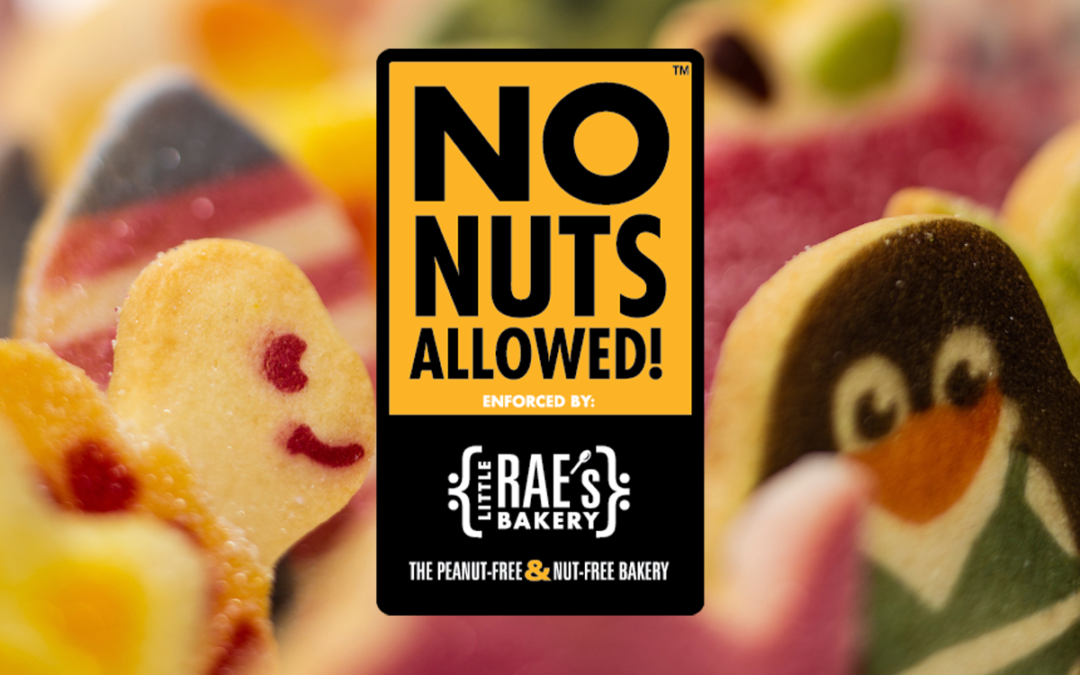You probably already know that we take peanut and tree nut allergies pretty seriously here at Little Rae’s Bakery (no ifs, ands, or nuts about it!). Our goal is to create delicious treats that can be safely enjoyed by everyone, including people who have peanut and tree nut allergies. We know just how difficult and frustrating it can be to find foods that are safe for those with nut allergies to consume, and it’s just one of the reasons we have a peanut and tree nut-free facility.
Little Rae’s No-Nuts Policy
Little Rae’s founder James Morse is highly allergic to peanuts and tree nuts, and that’s why we have a “No Nuts Allowed” policy. We don’t mess around when it comes to peanut and tree nut allergies because we know just how severe of a problem it can be. We enforce strict protocols in our bakery; meticulously organize, check, and approve everything from our local ingredients and various suppliers; and confirm that any visitor to our bakery has not been in contact with any peanuts or tree nuts before entering our bakery. We even have “No Nuts Allowed” signs in our front window to help start the conversation.
It takes a lot of work to maintain a nut-free facility, but it’s worth it to us to see the smiles on the faces of our smallest fans—and the look of relief on parents’ faces when they realize their child can safely enjoy our treats.
What Are the Top Food Allergies?
We focus on tree nuts and peanuts, but they’re just two of the top 9 most common food allergies. And while our facility is not free of all the others, we wanted to help spread the word about what they are.
If you had to guess, what would you say the other 7 top food allergies are? Most people can guess a few, but getting all 9 can be tricky, so we’ve broken it down for you below. When you’re aware of which foods are the most common allergies, it can help you know when to call out specific ingredients in foods you make and purchase, keeping everyone safer.
#1 Cow’s Milk
This allergy appears most often in babies and young children, but most outgrow it within a couple of years. With cow’s milk allergies, the treatment is to avoid products that contain it, such as milk, milk powder, cheese, butter, margarine, yogurt, cream, and ice cream. Note that a cow’s milk allergy is not the same as being lactose intolerant (more on allergies vs. intolerances later).
#2 Eggs
This allergy is also one of the most common in children, but about 2/3 (68%) will outgrow it by their Sweet Sixteen. The allergy may be to eggs as a whole, but it can also be specifically to either the yolk or the white (the white is more common). Like milk, avoiding eggs is the best treatment—but interestingly, this is not necessarily true in all cases. When heated, the egg protein structure can change, which means some individuals will no longer react to it. A large portion of children with egg allergies have been found to be tolerant of baked goods with egg in them, but as this is not true in all cases, you should check with your doctor before attempting this.
#3 Tree Nuts
This one we’re pretty familiar with. It includes all nuts and seeds that come from trees, such as brazil nuts, almonds, cashews, macadamia nuts, pistachios, pine nuts, and walnuts. Generally, if an individual is allergic to one type of tree nut, they are more susceptible to developing allergies to other tree nuts, so they should avoid all tree nuts to be safe—as allergic reactions to nuts can be very severe. Tree nut allergies are generally life-long and will not be outgrown like some allergies. A tree nut allergy can be life-threatening, and approximately 50% of all anaphylaxis-related deaths are due to tree nut allergies. Individuals with tree nut allergies should carry an epi-pen at all times, in case of a severe allergic reaction.
#4 Peanuts
Peanuts do not grow on trees and are technically legumes, but many who are allergic to peanuts are also allergic to tree nuts. Like tree nut allergies, peanut allergies can be severe. Unlike tree nuts, some children with peanut allergies do eventually outgrow it in their teenage years (15-22%), but most of the time it is a lifelong allergy. People with a peanut allergy should avoid peanuts and all foods containing peanuts. For those with severe allergies, avoiding food that has been prepared in an environment where peanuts are used at all—even in other products—is advised.
#5 Shellfish
The fifth most common allergy is to shellfish, which includes the crustacean and mollusk families of fish, such as shrimp, prawns, crayfish, lobster, squid, and scallops. This allergy tends to be life-long, and individuals with it are advised to avoid seafood altogether—as even cooking vapors from shellfish can trigger a reaction.
#6 Wheat
Wheat allergies are most common in children, but the majority outgrow it by the time they turn 10. This allergy can also be severe, and individuals with it should avoid wheat and products containing wheat—including beauty and skincare products. A wheat allergy is not the same as celiac disease and non-celiac gluten sensitivity. A wheat allergy is an immune response to one of the many proteins found specifically in wheat, while celiac and non-celiac gluten sensitivity are specifically an immune reaction to gluten (which is found in wheat and a number of other grains).
#7 Soy
Soy allergies are most common in infants and children under 3 and are triggered by a protein found in soybeans and products containing soybeans. About 70% will outgrow this allergy. Soy is a sneaky ingredient contained in a lot of products, so be sure to check the labels of any packaged foods for soy or soybean.
#8 Fish
Fish allergies are one of the few allergies that tends to develop later in life—a full 40% of people with a fish allergy developed it as adults. Fish allergies can be severe, and individuals who have one are advised to always carry an epi-pen.
#9 Sesame
This food allergy has long been left off “top allergies” lists, but under the FASTER Act of 2021, it will be listed as the 9th most common food allergy—and must be labeled on products as an allergen as of January 1, 2023. Currently, it is usually listed in the ingredients, but when it is part of a natural flavoring or spice or is not included in the common name of a food (like tahini, which is simply ground sesame seeds), it is not. This can obviously cause serious issues for those with sesame allergies, whose reactions can range from mild to severe. Those with sesame allergies are advised to keep an epi-pen on them at all times in case of anaphylaxis. If you have a sesame allergy or know someone with one, the following foods/ingredients should be avoided: benne, benne seed, benniseed, gingelly, gingelly oil, gomasio, halvah, sesame flour, sesame oil, sesame paste, sesame salt, sesame seed, sesamol, sesamum indicum, sesemolina, sim sim, tahini, tahina, tehina, and til.
Food Allergies vs. Food Intolerances
Is it an allergy or an intolerance? It comes down to one simple thing: whether or not the reaction is an immune response. With food allergies, the body’s immune system wrongly identifies one or more of the proteins in a certain food as harmful and launches a slew of protective measures to combat them. This can cause symptoms like swelling of the tongue mouth, or face; difficulty breathing; low blood pressure; vomiting, diarrhea; hives; itchy rashes; and, in severe cases, anaphylaxis.
Meanwhile, a food intolerance does not involve the body’s immune system at all. Intolerances happen when the body is unable to properly digest a food—such as with lactose intolerance and gluten intolerance. They can cause a variety of digestive discomforts and other issues but are not life threatening.
Food Allergy Resources
We’ve just barely touched the tip of the food-allergy iceberg, but there are a TON of resources available for those interested in learning more about food allergies and how to help create a safer world for those who suffer from them. Here are a few of our favorites—please feel free to share additional resources you recommend in the comments!
- Food Allergy Research & Education (FARE)
- Seattle Food Allergy Consortium (SeaFAC)
- Kids with Food Allergies
- The American College of Allergy, Asthma and Immunology

